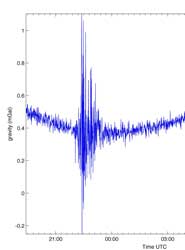Based in his office in the Wills Memorial Building of the Earth Sciences Department, Dr Joachim Gottsmann recorded incoming seismic waves from the earthquake. It took the waves 20 minutes or so to travel from the earthquake's hypocentre below Haiti, arriving in Bristol just after 10 pm on Tuesday 12 January.
The location of an earthquake's hypocentre is the point in the Earth from which the stored energy is first released. It occurs at depth below the epicentre, which is the location on the Earth's surface directly above the point where the fault begins to rupture.
Seismic waves are waves of energy caused by the sudden breaking of rock within the Earth. There are several different kinds and they all move in different ways. The ones recorded by Gottsmann are surface waves that can only travel through the Earth’s crust (rather than through the whole Earth). It is surface waves that are almost entirely responsible for the damage and destruction associated with earthquakes.
Dr Gottsmann normally uses the instrument called a gravimeter to look at the processes going on in the Earth's crust associated with volcanoes, but it also picks up signals from earthquakes, particularly large ones like the magnitude 7 earthquake that occurred below Haiti.
He said: “I came in on Wednesday morning to find we had picked up signals from the Haiti earthquake the previous night. There's also a lot of seismic activity going on this week around the Pacific Rim, an area known for its volcanoes and earthquakes.”
Make a donation to the appeal fund now.

